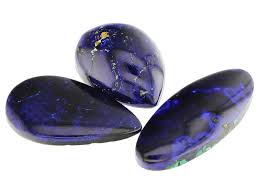
Azurite: The Blue Flame of Intuition and Inner Vision
Among the many blue stones that dazzle both collectors and healers, Azurite stands apart with its velvety richness and mystical legacy. Its deep, saturated blues have enchanted civilisations for millennia — from ancient Egyptian priests to mediaeval painters who ground it into ultramarine pigment. Today, it continues to hold a powerful place in the realm of raw crystal jewellery and energetic healing.
This blog explores Azurite’s geological origins, metaphysical properties, visual uniqueness, and its growing presence in mineral specimen jewellery — especially in its raw, unpolished state that retains full vibrational potency.

Geological Profile of Azurite
Chemical Composition: Cu₃(CO₃)₂(OH)₂
Crystal System: Monoclinic
Mohs Hardness: 3.5 to 4
Common Colours: Deep royal blue, often with vivid banding or fibrous structures
Associated Minerals: Commonly found alongside Malachite, Chrysocolla, and Native Copper
Azurite is a copper carbonate hydroxide mineral that forms in the oxidised zones of copper ore deposits. It often grows in radiating clusters, tabular prisms, or botryoidal masses, and sometimes coexists with Malachite, forming the well-loved hybrid “Azurmalachite.”
Main sources include:
-
Democratic Republic of the Congo
-
Morocco (particularly the Touissit mine)
-
Australia
-
USA (notably Arizona and New Mexico)
In raw form, Azurite’s aesthetic is almost painterly — ranging from intense sapphire-like shards to powdery blue clusters — making it a dream material for those creating handmade gemstone rings or raw crystal necklaces.
Metaphysical Meaning and Healing Energy
Historically associated with priesthood, prophecy, and sacred knowledge, Azurite is revered for its effects on the third eye and throat chakras. It is often described as a “stone of insight,” helping to awaken intuition, clarify dreams, and deepen meditation.
Key Energetic Properties:
-
Enhances psychic perception: Azurite is used by energy workers to stimulate clairvoyance and strengthen the inner eye.
-
Facilitates communication: By activating the throat chakra, it helps with honest expression and articulation of one’s inner truth.
-
Emotional clarity: Useful during shadow work, Azurite can surface subconscious fears or limiting patterns for transformation.
-
Mental discipline: Ideal for students, spiritual seekers, and those doing focused study or divination.
Unlike gentler blue stones like Blue Lace Agate, Azurite is piercing, direct, and catalytic — better suited for those ready to confront illusions and embrace spiritual maturity.
Unique Appeal in Natural Form
When unpolished, Azurite maintains an organic, untouched feel — its chalky matte texture and crystalline geometry radiate unfiltered energy. While more delicate than quartz-based stones, its raw form is especially beloved in crystal specimen rings and pendant designs that celebrate its celestial blue tones and natural matrix.
The stone’s fragility means it’s often protected in open bezel settings or encased in resin, allowing wearers to enjoy its full vibrancy without compromising structure. Each piece of raw Azurite jewellery is a miniature landscape of the Earth — a vivid snapshot of copper’s slow alchemical artistry.
Azurite vs. Similar Crystals
While often compared to other blue stones, Azurite has distinct metaphysical and visual traits:
-
Lapis Lazuli has golden pyrite flecks and a deeper navy tone, offering more grounded wisdom and protection.
-
Sodalite is a cooler, more rational stone, aiding logic and clarity, while Azurite dives straight into intuitive and mystical realms.
-
Chrysocolla, another copper-based mineral, exudes a more feminine, nurturing energy. In contrast, Azurite feels like a spiritual initiator or teacher.
Collectors and crystal workers often pair Azurite with Malachite for balanced energetic alignment — Malachite grounds and detoxifies, while Azurite uplifts and expands perception.

Use in Raw Crystal Jewellery
In mineral specimen jewellery, Azurite’s deep indigo allure pairs well with oxidised silver and bronze settings, evoking ancient artefacts. At Oryssia, we embrace its raw majesty — uncut, unrefined — preserving the undisturbed geometry and frequency of the Earth’s inner language.
Because of its relatively soft structure, Azurite is best used in:
-
Crystal specimen pendants
-
Handcrafted rings with protective bezels
-
Statement brooches and cuffs
-
Small altar pieces or pocket stones rather than daily wear rings (unless reinforced)
Its unpredictable veining and occasional blending with Malachite create pieces that are not only beautiful but genuinely one-of-a-kind.
Myth, Lore and Spiritual Use
In Ancient Egypt, Azurite was ground and worn by priests to connect with divine intelligence. It was also believed to bridge the earthly and the celestial, helping one download cosmic knowledge into human understanding.
The Mayans used Azurite in ritual and visionary practice, seeing it as a stone of initiation, inner vision and transformation — ideal for use in sacred space, dreamwork, or third eye meditations.
Subtle Brand Mention
In our journey of designing jewellery with soul, we are drawn to stones like Azurite — raw, mysterious, uncompromising. Every piece crafted with it becomes a small talisman of insight and awakening, echoing the mineral's ancient purpose in a modern, wearable form.